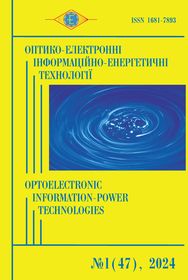Optical fundus image segmentation methods
DOI:
https://doi.org/10.31649/1681-7893-2024-47-1-155-165Keywords:
Fundus, Matlab, optical image segmentation methodAbstract
The paper presents a comparative analysis and evaluation of methods for segmenting optical fundus images in order to study their efficiency, accuracy, completeness, and computational complexity in Matlab. The methods analyzed are Otsu, adaptive thresholding, Watershed, K-means, maximum expectation algorithm (EM), and Frangi method. The features, advantages and disadvantages in the context of application for the diagnosis of fundus diseases are considered.
References
Wójcik, W., Pavlov, S., Kalimoldayev, M. (2019). Information Technology in Medical Diagnostics II. London: Taylor & Francis Group, CRC Press, Balkema book. – 336 Pages, https://doi.org/10.1201/ 9780429057618. eBook ISBN 9780429057618.
Grychaniuk, I., & Nosovets, O. (2021). Analysis of data augmentation methods for retinal vessel segmentation tasks. Molodyi vchenyi, 10 (98), 1-5. URL: https://doi.org/10.32839/2304-5809/2021-10-98-23.
Almotiri, J.; Elleithy, K.; Elleithy, A. (2018). Retinal Vessels Segmentation Techniques and Algorithms: A Survey. Appl. Sci., 8, 155. URL: https://doi.org/10.3390/app8020155
Ilesanmi, A. E., Ilesanmi, T., & Gbotoso, G. A. (2023). A systematic review of retinal fundus image segmentation and classification methods using convolutional neural networks. Healthcare Analytics, 4, 100261. ISSN 2772-4425. URL: https://doi.org/10.1016/j.health.2023.100261.
Gilat, A. (2004). MATLAB: An Introduction with Applications 2nd Edition. John Wiley & Sons. ISBN 978-0-471-69420-5.
Retinal Image Preprocessing: Background and Noise Segmentation. ResearchGate. URL: https://www.researchgate.net/publication/260350802_Retinal_Image_Preprocessing_Background_and_Noise_Segmentation
Sarki, R., Ahmed, K., Wang, H., Zhang, Y., Ma, J., & Wang, K. (2021). Image Preprocessing in Classification and Identification of Diabetic Eye Diseases. Data Sci Eng., 6(4), 455-471. URL: https://www.ncbi.nlm.nih.gov/pmc/articles/PMC8370665/
Niemeijer, M., Staal, J., van Ginneken, B., Loog, M., & Abramoff, M. D. (2004). Comparative study of retinal vessel segmentation methods on a new publicly available database. Proc. SPIE 5370, Medical Imaging 2004: Image Processing, (12 May 2004). URL: https://doi.org/10.1117/12.535349.
Saha Tchinda, B., Tchiotsop, D., Noubom, M., Louis-Dorr, V., & Wolf, D. (2021). Retinal blood vessels segmentation using classical edge detection filters and the neural network. Informatics in Medicine Unlocked, 23, 100521. ISSN 2352-9148. URL: https://doi.org/10.1016/j.imu.2021.100521.
Otsu, N. (1979). A threshold selection method from gray-level histograms. IEEE Transactions on Systems, Man, and Cybernetics, 9(1), 62-66. URL: https://ieeexplore.ieee.org/document/4310076
Bradley, D., & Roth, G. (2007). Adaptive thresholding using the integral image. Journal of Graphics Tools, 12(2), 13-21. URL: https://doi.org/10.1080/2151237X.2007.10129236.
Marciniak, T., Stankiewicz, A., & Zaradzki, P. (2023). Neural Networks Application for Accurate Retina Vessel Segmentation from OCT Fundus Reconstruction. Sensors, 23, 1870. URL: https://doi.org/10.3390/s23041870.
Introduction to K-Means Clustering Algorithm. Analytics Vidhya. URL: https://www.analyticsvidhya.com/blog/2019/08/comprehensive-guide-k-means-clustering/.
Sigworth, F. J., Doerschuk, P. C., Carazo, J. M., & Scheres, S. H. (2010). An introduction to maximum-likelihood methods in cryo-EM. Methods Enzymol., 482, 263-94. URL: https://doi.org/10.1016/S0076-6879(10)82011-7.
Frangi, A. F., Niessen, W. J., Vincken, K. L., & Viergever, M. A. (1998). Multiscale vessel enhancement filtering. Lecture Notes in Computer Science, 1496, 130-137. URL: https://doi.org/10.1007/BFb0056195.
Pavlov S.V., Martianova T.A., Saldan Y.R., and etc., “Methods and computer tools for identifying diabetes-induced fundus pathology”, Information Technology in Medical Diagnostics II. CRC Press, Balkema book, Taylor & Francis Group, London, UK, 87-99, 2019.
SaldanYosyp, Sergii Pavlov, Vovkotrub Dina, Waldemar Wójcik, and etc., “Efficiency of optical-electronic systems: methods application for the analysis of structural changes in the process of eye grounds diagnosis,”, Proc. SPIE 10445, Photonics Applications in Astronomy, Communications, Industry, and High Energy Physics Experiments 2017, 104450S (2017).
Lytvynenko, V., Lurie, I., Voronenko, M., etc., “The use of Bayesian methods in the task of localizing the narcotic substances distribution,” International Scientific and Technical Conference on Computer Sciences and Information Technologies, 2, 8929835, 60–63 (2019).
Friedman, Jerome, Trevor Hastie, and Robert Tibshirani., “The elements of statistical learning,” hastie.su.domains/ElemStatLearn (2009).
Kvyetnyy Roman, Bunyak Yuriy, Sofina Olga, and etc., "Blur recognition using second fundamental form of image surface," Proc. SPIE 9816, Optical Fibers and Their Applications 2015, 98161A (17 December 2015).
Zabolotna, N. I., Sholota V. V., Okarskyi H. H.,“Methods and systems of polarization reproduction and analysis of the biological layers structure in the diagnosis of pathologies,” Proc. SPIE 11369, 113691S (2020).
Avrunin O.G., Tymkovych M.Y., Saed H.F.I., etc., “Application of 3D printing technologies in building patient-specific training systems for computing planning in rhinology,” Information Technology in Medical Diagnostics II - Proceedings of the International Scientific Internet Conference on Computer Graphics and Image Processing and 48th International Scientific and Practical Conference on Application of Lasers in Medicine and Biology, 7 (2019).
Selivanova K.G., Avrunin O.G., Tymkovych M.Y., Manhora T.V., etc., “3D visualization of human body internal structures surface during stereo-endoscopic operations using computer vision techniques,” Przeglad Elektrotechniczny, 9, 30-33 (2021).
Tymkovych M., Gryshkov O., Avrunin O., Selivanova K., etc. “Application of SOFA Framework for Physics-Based Simulation of Deformable Human Anatomy of Nasal Cavity”, IFMBE Proceedings, 112 (2021).
Downloads
-
PDF (Українська)
Downloads: 83
Published
How to Cite
Issue
Section
License
Автори, які публікуються у цьому журналі, погоджуються з наступними умовами:- Автори залишають за собою право на авторство своєї роботи та передають журналу право першої публікації цієї роботи на умовах ліцензії Creative Commons Attribution License, котра дозволяє іншим особам вільно розповсюджувати опубліковану роботу з обов'язковим посиланням на авторів оригінальної роботи та першу публікацію роботи у цьому журналі.
- Автори мають право укладати самостійні додаткові угоди щодо неексклюзивного розповсюдження роботи у тому вигляді, в якому вона була опублікована цим журналом (наприклад, розміщувати роботу в електронному сховищі установи або публікувати у складі монографії), за умови збереження посилання на першу публікацію роботи у цьому журналі.
- Політика журналу дозволяє і заохочує розміщення авторами в мережі Інтернет (наприклад, у сховищах установ або на особистих веб-сайтах) рукопису роботи, як до подання цього рукопису до редакції, так і під час його редакційного опрацювання, оскільки це сприяє виникненню продуктивної наукової дискусії та позитивно позначається на оперативності та динаміці цитування опублікованої роботи (див. The Effect of Open Access).


